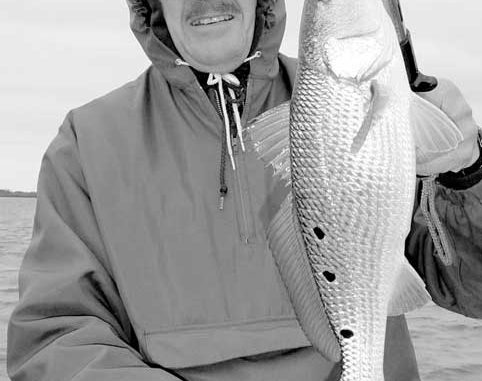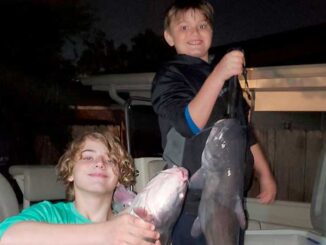
Sick of the winter doldrums yet? Then head to Hopedale, where ample redfish action will make you glad it’s not summer.
February is generally considered one of the toughest months for inshore saltwater fishing in Louisiana. Although fall and early winter speckled trout fishing can be fantastic, trout seem to go dormant in the depths of winter. Strong, cold winds and low water conditions can make for uncomfortable, unproductive fishing.
However, for the angler who carefully picks his location and technique, cold-weather redfish can provide hot wintertime action.
Redfish are much more tolerant of cold water than speckled trout. While these two species are oftentimes caught side by side, wintertime reds can be much more active and predictable. When the trout get lockjaw, many knowledgeable fishermen turn to cold weather reds to satisfy their winter fishing needs.
Many fishermen believe that redfish magically appear in the winter marsh, that they must migrate there. The truth is that they were there all along, but winter conditions make them more accessible and tend to concentrate them. Frequent cold fronts will drop water levels and provide less area for the reds to inhabit. Many a winter trout fishing trip has been salvaged by stumbling into some cold-water redfish.
Redfish are primarily bottom grubbers. They make their living scouring the water bottoms rooting out all sorts of critters that end up in their powerful crushers. Crabs and shrimp are particular favorites.
In times of normal or above-normal water levels, redfish will work their way into areas of the marsh that most fishermen can’t access. It is not uncommon to spot redfish feeding in water so shallow that their tails and backs stick out of the water.
But wintertime is different, with the water gone from all the cracks and crevices, redfish will be forced to move out of these inaccessible areas. If the temperatures are extremely cold, they will bunch up in the deeper holes of nearby bayous and dead-end canals.
However, as the water warms on cold, sunny days, reds will move back into the shallower areas along the edges of the lakes, bays and lagoons to feed.
Understanding their cold-weather behavior can put you onto consistent action for these bronze bruisers. Find them in these patterns, and you can have your limit in short order and be back home to thaw in front of the fireplace.
One of the best locations for February redfish is the small fishing camp village of Hopedale, which is located at the eastern end of St. Bernard Parish.
No one relishes the thought of a long, bitterly cold boat ride. Fortunately, Hopedale has convenient launch facilities and short boat runs through protected waters, which makes for comfortable trips even on those not-so-perfect days. There are many prime redfish areas within minutes of launching.
When it comes to wintertime redfish, Hopedale has all the necessary features to make a successful trip under varying conditions. For those cold days when they are holding deep, there are numerous bayous, pipelines and dead-end canals that provide suitable habitat. On those warmer days when they move a little shallower, you can easily fish an endless array of lagoons, lakes and bays that the redfish will seek.
Few anglers know this area better than Capt. Warren Dudenhefer of Dudenhefer’s Fishing Charters. “Capt. Dude,” as he is known locally, is a Hopedale native who grew up fishing these waters both recreationally and commercially.
His charter operation is based on Bayou La Loutre at the intersection of Dudenhefer’s Canal. Just across the highway from his dock is his childhood home and the “Oak Tree” camp that was built by his grandparents in the early 1950s. Today, he rents out the Oak Tree and another camp to his overnight charter guests and fishermen who use their own boat but need a place to stay.
His family used to operate Dudenhefer’s Marina, which is now closed. Generations of family knowledge allow Dudenhefer to consistently put his clients on fish and to provide expert advice on fishing the entire Hopedale area.
Dudenhefer loves winter redfishing in Hopedale.
“The good thing about Hopedale is that the fishing is not adversely affected by the fresh water that moves into the Delacroix area during winter,” said Dudenhefer.
The Caernarvon Freshwater Diversion is operated at higher levels during the winter months, and the fresh, Mississippi-mud-stained river water can sometimes make for tough fishing conditions on the Delacroix side of Bayou Terre aux Boeufs.
“The operation of the siphon actually moves more fish into the cleaner waters of the Hopedale area,” Dudenhefer said. “The Hopedale marsh is teeming with locations to find wintertime redfish in almost any conditions, without going too far.”
The list of baits Dudenhefer prefers for winter redfish is short. The only live bait available at this time of year is cocahoes. The only other natural bait Dudenhefer uses is dead shrimp either under a cork or on the bottom.
“Dead shrimp is a must-use if the water is muddy,” he said.
As for plastic baits, Dudenhefer relies almost exclusively on the old standby, the H&H sparkle beetle. His two top colors are clear and chartreuse.
“You cannot beat these baits: They are tough, inexpensive and they catch fish,” he said.
He will also occasionally use the H&H original plastic cocahoe in purple/white.
If you pick your days right, the water will be generally very clear. With the absence of shrimp in the marsh this time of year, the reds will eagerly devour those plastic baits.
“I prefer to fish just before or on the third day after the passing of a cold front. By this time, the water has cleared up, the temperature has risen and the fish will feed more actively,” said Dudenhefer.
When the fish are deep on cold days, Dudenhefer will slowly work live, Carolina- rigged cocahoes up from the middle of deep bayous or dead-ends. Areas like Middle Bayou, Bayou Robin and the various pipelines and dead-ends provide plenty of deep holes in which the redfish congregate. A depth-finder is an invaluable tool for locating such areas.
“Position your boat so that you can throw your cocaho out to the middle and crawl the bait back up the ledges toward the boat,” Dudenhefer advised.
He will also fish the beetles in a similar manner, feeling for a bite the whole way in. Wintertime bites tend to be subtle, and Dudenhefer advises to fish slow and set the hook whenever the retrieve feels “a little different.”
When fishing these deeper areas, Dudenhefer seeks out only those spots that have an oyster shell bottom.
“I don’t fish a plain mud bottom,” he said. “Finding oysters is a key to redfish in the bayous.”
One advantage of the low water is that the exposed banks can make finding the oyster bar areas easy.
“If you can see the oysters on the banks, you can pretty well bet that they extend down into the depths of that area also,” said Dudenhefer. “This is a good time to mark your maps and GPS for these locations since they aren’t visible during normal water levels.”
Under the right conditions and location, you can find these deep-water redfish stacked up, and can easily limit out without moving the boat.
However, the redfish are not always in the deep areas. They will move into adjacent shallows with just the slightest change of conditions or a rise in the water temperature. A bright winter sun can quickly warm shallow areas by radiating through the gin-clear water into the dark sediment bottoms. The water temperature in these areas can rise several degrees in just a few hours. When this happens, the baitfish will become more active, and so will the reds.
“After a string of mild days or later in the day on cold, sunny days, you will start to see mullets along the grass. That’s when you move to the edges of the lakes, bays and lagoons,” said Dudenhefer.
At these times, Dudenhefer prefers to use his clear and chartreuse sparkle beetles.
“In darker water or low-light conditions, I use chartreuse because I believe they can see it better,” he said.
He will fish the grass edges and cuts along the shore with the beetle about 2 feet under a Cajun Thunder popping cork. He will also tight-line them on either a 1/4- or 3/8-ounce jighead, depending on the strength of the current.
Dudenhefer suggests trolling or drifting the shoreline of areas like Hopedale Lagoon, Lake Ameda or Lake Amedee.
“The fish tend to stay together more, and once you find them you are likely to catch several in that location,” he said.
Although he does not use them often, Dudenhefer acknowledges that weedless gold spoons are also an effective wintertime redfish bait. They can be slow-rolled right through the grass, and that gold flash can be deadly in the clear water.
When Dudenhefer operated his family’s marina, he regularly advised fishermen on all of the local hotspots. He even gave out photocopied maps of the area with over 50 of the best Hopedale fishing locations clearly marked.
Though many charter captains would rather give you their first born before their list of hot spots, Dudenhefer eagerly marked a map with over 25 of his favorite Hopedale redfish spots. These are the same areas where he regularly takes his clients.
Two full-service launches are available in Hopedale — Pip’s Place and Breton Sound Marina. From either, access to these honeyholes is easy through Hopedale Bayou or Dudenhefer’s Canal. You will burn very little gas, and can be reeling in redfish in just a few minutes. You can also access the area from the Reggio Marina by taking a 6 1/2-mile run down Reggio Canal directly into Lake Amedee.
Dudenhefer prefers to start close and work his way farther out, only if necessary.
“I’ll start off in Lake Ameda or Hopedale Lagoon. Many a trip has been finished without going any farther than this,” said Dudenhefer.
If the fish are not cooperating, Dudenhefer suggests that you fish your way farther into the Hopedale marsh.
“Instead of automatically running to distant locations, if you slowly move to adjacent areas, you may find the fish without moving that far,” he said. “All of these areas contain the deep holes and shallower areas necessary to find redfish under various winter conditions. Once you establish the pattern, you will be able to successfully repeat it throughout the area.”
Dudenhefer also recommends that you not overlook the larger bodies of water.
“The shorelines of larger lakes, like Lake Robin and Lake Amedee, can hold a lot of redfish in the winter,” he said.
Although these areas can get rough on windy days, the lee shores can provide many cuts and coves that will provide calm areas to fish.
Winter redfishing can provide great sport on an otherwise useless day. You can get up a lot later since the action will generally pick up as the day warms, and it will likely not be too crowded as many fishermen do not realize the excellent fishing that can be had this time of year.
To book a charter or for additional information on the Hopedale area, call Capt. Warren Dudenhefer at (504) 676-3724.
